Evapotranspiration and Inputs of Salts to Soil in Irrigated Millet with Wastewater
Abstract
1. Introduction
2. Materials and Methods
3. Results and Discussion
3.1. Millet Phytomass Accumulation
3.2. Analysis of Millet Evapotranspiration
3.3. Millet Water Use Efficiency (WUE)
3.4. Soil Salts Inputs
4. Conclusions
Author Contributions
Funding
Data Availability Statement
Acknowledgments
Conflicts of Interest
Abbreviations
| AWC | available water content |
| DM | dry matter |
| DMP | dry matter production |
| ET | evapotranspiration |
| ECse | electrical conductivity of the soil saturation extract |
| FC | field capacity |
| Na+ | soluble sodium |
| PWP | permanent wilting point |
| T1 | 100% available water content without manure |
| T2 | 75% available water content without manure |
| T3 | 50% available water content without manure |
| T4 | 25% available water content without manure |
| T5 | 100% available water content with manure |
| T6 | 75% available water content with manure |
| T7 | 50% available water content with manure |
| T8 | 25% available water content with manure |
| WUE | water use efficiency |
References
- Qiu, Y.; Liu, C.; Du, L.; Jiang, X.; Yuan, D. Study on the safety of recycled water irrigation in arid, semiarid and underdeveloped areas: A case study in Qinghai Province. Irrig. Sci. 2024, 42, 769–783. [Google Scholar] [CrossRef]
- Chen, C.Y.; Wang, S.W.; Kim, H.; Pan, S.Y.; Fan, C.; Lin, Y.J. Non-conventional water reuse in agriculture: A circular water economy. Water Res. 2021, 199, 117193. [Google Scholar] [CrossRef]
- Erel, R.; Eppel, A.; Yermiyahu, U.; Ben-Gal, A.; Levy, G.; Ziporia, I.; Schaumann, G.E.; Mayer, O.; Daga, A. Long-term irrigation with reclaimed wastewater: Implications on nutrient management, soil chemistry and olive (Olea europaea L.) performance. Agric. Water Manag. 2019, 213, 324–335. [Google Scholar] [CrossRef]
- Menezes, L.A.N.; Mattos, A.T. Condutividade elétrica do solo em função da dose de aplicação de água residuária em áreas de fertirrigação. Rev. Eng. Agric. 2018, 26, 383–389. [Google Scholar] [CrossRef]
- Silva, J.R.; Souza, E.; Leite, M.L.D.; Barros Junior, G.; Sales, A.T.; Antonino, A.C. Gas exchange and millet phytomass under organic fertilization and graywater irrigation. Rev. Bras. Eng. Agríc. Ambient. 2022, 26, 111–118. [Google Scholar] [CrossRef]
- Farooq, M.; Hussain, M.; Allah, S.U.; Siddique, K.H.M. Physiological and agronomic approaches for improving water-use efficiency in crop plants. Agric. Water Manag. 2019, 219, 95–108. [Google Scholar] [CrossRef]
- Garcia-Cuerva, L.; Berglund, E.Z.; Binder, A.R. Public perceptions of water shortages, conservation behaviors, and support for water reuse in the US. Resour. Conserv. Recycl. 2016, 113, 106–115. [Google Scholar] [CrossRef]
- Schaer-Barbosa, M.; Santos, M.E.P.; Medeiros, Y.P. Viabilidade do reúso de água como elemento mitigador dos efeitos da seca no semiárido da Bahia. Ambiente Soc. 2014, 17, 17–32. [Google Scholar] [CrossRef][Green Version]
- Leong, J.Y.C.; Oh, K.S.; Poh, P.E.; Chong, M.N. Prospects of hybrid rainwater-greywater decentralised system for water recycling and reuse: A review. J. Clean. Prod. 2017, 142, 3014–3027. [Google Scholar] [CrossRef]
- Madzaramba, T.H.; Zanamwe, P. User perceptions and acceptance of treated greywater reuse in low-income communities: A narrative review. J. Water Clim. Change 2023, 14, 4236–4244. [Google Scholar] [CrossRef]
- Cirilo, J.A.; Montenegro, S.M.; Campos, J.N.B. The issue of water in the Brazilian semi-arid region. In Waters of Brazil: Strategic Analysis; Springer Nature: Berlin, Germany, 2017; pp. 59–71. [Google Scholar]
- Nicolau Sobrinho, W.; Santos, R.V.; Menezes Júnior, J.C.; Souto, J.S. Acúmulo de nutrientes nas plantas de milheto em função da adubação orgânica e mineral. Rev. Caatinga 2009, 22, 107–110. [Google Scholar]
- Casaroli, D.; Jong Van Lier, Q. Critérios para determinação da capacidade de vaso. Rev. Bras. Ciênc. Solo 2008, 32, 59–66. [Google Scholar] [CrossRef]
- Detmann, E.; Souza, M.A.; Valadares Filho, S.C.; Queiroz, A.C.; Berchielli, T.T.; Saliba, E.O.; Cabral, L.S.; Pina, D.S.; Ladeira, M.M.; Azevedo, J.A.G. Métodos Para Análise de Alimentos, 1st ed.; Suprema: Visconde do Rio Branco, Brazil, 2012. [Google Scholar]
- Freire, M.B.G.S.; Pessoa, L.G.M.; Gheyi, H.R. Métodos de análises químicas para solos salinos. In Manejo da Salinidade na Agricultura: Estudos Básicos E Aplicados, 2nd ed.; Ghey, H.R., da Silva Dias, N., de Lacerda, C.F., Filho, E.G., Eds.; INCTSal: Fortaleza, Brazil, 2016; pp. 489–501. [Google Scholar]
- R Core Team. R: A Language and Environment for Statistical Computing; R Foundation for Statistical Computing: Vienna, Austria, 2013; Available online: https://www.R-project.org/ (accessed on 23 February 2025).
- Affholder, F. Effect of organic matter input on the water balance and yield of millet under tropical dryland condition. Field Crops Res. 1995, 41, 109–121. [Google Scholar] [CrossRef]
- Ghatak, A.; Chaturvedi, P.; Nagler, M.; Roustan, V.; Lyon, D.; Bachmann, G.; Postl, W.; Schröfl, A.; Desai, N.; Varshney, R.K.; et al. Comprehensive tissue-specific proteome analysis of drought stress responses in Pennisetum glaucum (L.) R. Br. (pearl millet). J. Proteom. 2016, 143, 122–135. [Google Scholar] [CrossRef]
- Al-Solaimani, S.G.; Alghabari, F.; Ihsan, M.Z.; Fahad, S. Water deficit irrigation and nitrogen response of Sudan grass under arid land drip irrigation conditions. Irrig. Drain. 2017, 66, 365–376. [Google Scholar] [CrossRef]
- Rodríguez, C.; Sánchez, R.; Rebolledo, N.; Schneider, N.; Serrano, J.; Leiva, E. Life cycle assessment of greywater treatment systems for water-reuse management in rural areas. Sci. Total Environ. 2021, 795, 148687. [Google Scholar] [CrossRef]
- Uppal, R.K.; Wani, S.P.; Garg, K.K.; Alagarswamy, G. Balanced nutrition increases yield of pearl millet under drought. Field Crops Res. 2015, 177, 86–97. [Google Scholar] [CrossRef]
- Rostamza, M.; Chaichi, M.R.; Jahansouz, M.R.; Alimadadi, A. Forage quality, water use and nitrogen utilization efficiencies of pearl millet (Pennisetum americanum L.) grown under different soil moisture and nitrogen levels. Agric. Water Manag. 2011, 98, 1607–1614. [Google Scholar] [CrossRef]
- Duarte, H.F.H.; Souza, E.R. Soil water potentials and Capsicum annuum L. under salinity. Rev. Bras. Ciênc. Solo 2016, 40, e0150220. [Google Scholar] [CrossRef]
- Gondal, A.H.; Tampubolon, K.; Toor, M.D.; Ali, M. Pragmatic and fragile effects of wastewater on a soil–plant–air continuum and its remediation measures: A perspective. Rev. Agric. Sci. 2021, 9, 249–259. [Google Scholar] [CrossRef] [PubMed]
- Comas, L.; Trout, T.J.; DeJonge, K.C.; Zhang, H.; Gleason, S.M. Water productivity under strategic growth stage-based deficit irrigation in maize. Agric. Water Manag. 2019, 212, 433–440. [Google Scholar] [CrossRef]
- Vadez, V.; Kholová, J.; Yadav, R.S.; Hash, C.T. Small temporal differences in water uptake among varieties of pearl millet (Pennisetum glaucum (L.) R. Br.) are critical for grain yield under terminal drought. Plant Soil 2013, 371, 447–462. [Google Scholar] [CrossRef]
- Beggi, F.; Falalou, H.; Buerkert, A.; Vadez, V. Tolerant pearl millet (Pennisetum glaucum (L.) R. Br.) varieties to low soil P have higher transpiration efficiency and lower flowering delay than sensitive ones. Plant Soil 2015, 389, 89–108. [Google Scholar] [CrossRef][Green Version]
- Ribeiro, M.R.; Ribeiro Filho, M.R.; Jacomine, P.K.T. Origem e classificação dos solos afetados por sais. In Manejo da Salinidade na Agricultura: Estudos Básicos e Aplicados, 2nd ed.; Gheyi, H.R., Dias, N.S., Lacerda, C.F., Gomes Filho, E., Eds.; INCTSal: Fortaleza, Brazil, 2016; pp. 9–15. [Google Scholar]
- Silva, J.R.I.; Jardim, A.M.R.F.; Barroso Neto, J.; Leite, M.L.M.V.; Teixeira, V.I. Estresse salino como desafio para produção de plantas forrageiras. Pesqui. Apl. Agrotecnol. 2018, 11, 127–139. [Google Scholar] [CrossRef]
- Ben-Gal, A.; Beiersdorf, I.; Yermiyahu, U.; Soda, N.; Presnov, E.; Zipori, I.; Crisostomo, R.R.; Dag, A. Response of young bearing olive trees to irrigation-induced salinity. Irrig. Sci. 2017, 35, 99–109. [Google Scholar] [CrossRef]
- Tal, A. Rethinking the sustainability of Israel’s irrigation practices. Water Res. 2016, 90, 387–394. [Google Scholar] [CrossRef] [PubMed]
- Corwin, D.L. Climate change impacts on soil salinity in agricultural areas. Eur. J. Soil Sci. 2021, 72, 842–862. [Google Scholar] [CrossRef]
- Oliveira, A.M.; Dias, N.S.; Gurgel, G.C.S.; Rabelo, L.N.; Melo, M.R.S.; Santos, M.V. Impactos físico-químicos do descarte de rejeito salino em Neossolo e Chernossolo do oeste potiguar, Brasil. Irriga 2018, 23, 413–425. [Google Scholar] [CrossRef]
- Amorim, T.L.; Santos, H.R.B.; Neto, J.B.; Herminio, P.J.; Silva, J.R.I.; Silva, M.M.A.; Simões, A.N.; Souza, E.; Ferreira-Silva, S.L. Resistant rootstocks mitigate ionic toxicity with beneficial effects for growth and photosynthesis in grapevine grafted plants under salinity. Sci. Hortic. 2023, 317, 112053. [Google Scholar] [CrossRef]
- Gao, Y.; Shao, G.; Wu, S.; Xiaojun, W.; Lu, J.; Cui, J. Changes in soil salinity under treated wastewater irrigation: A meta-analysis. Agric. Water Manag. 2021, 255, 106986. [Google Scholar] [CrossRef]
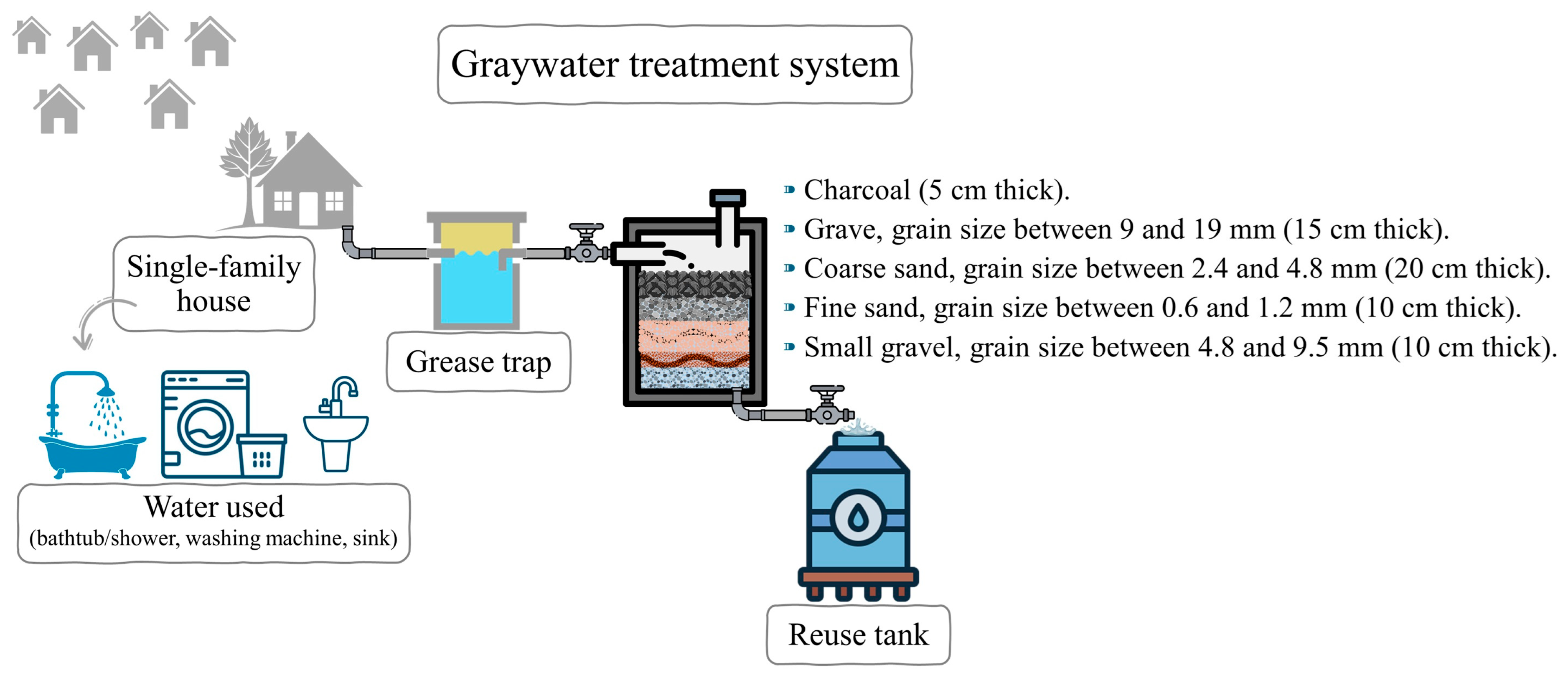
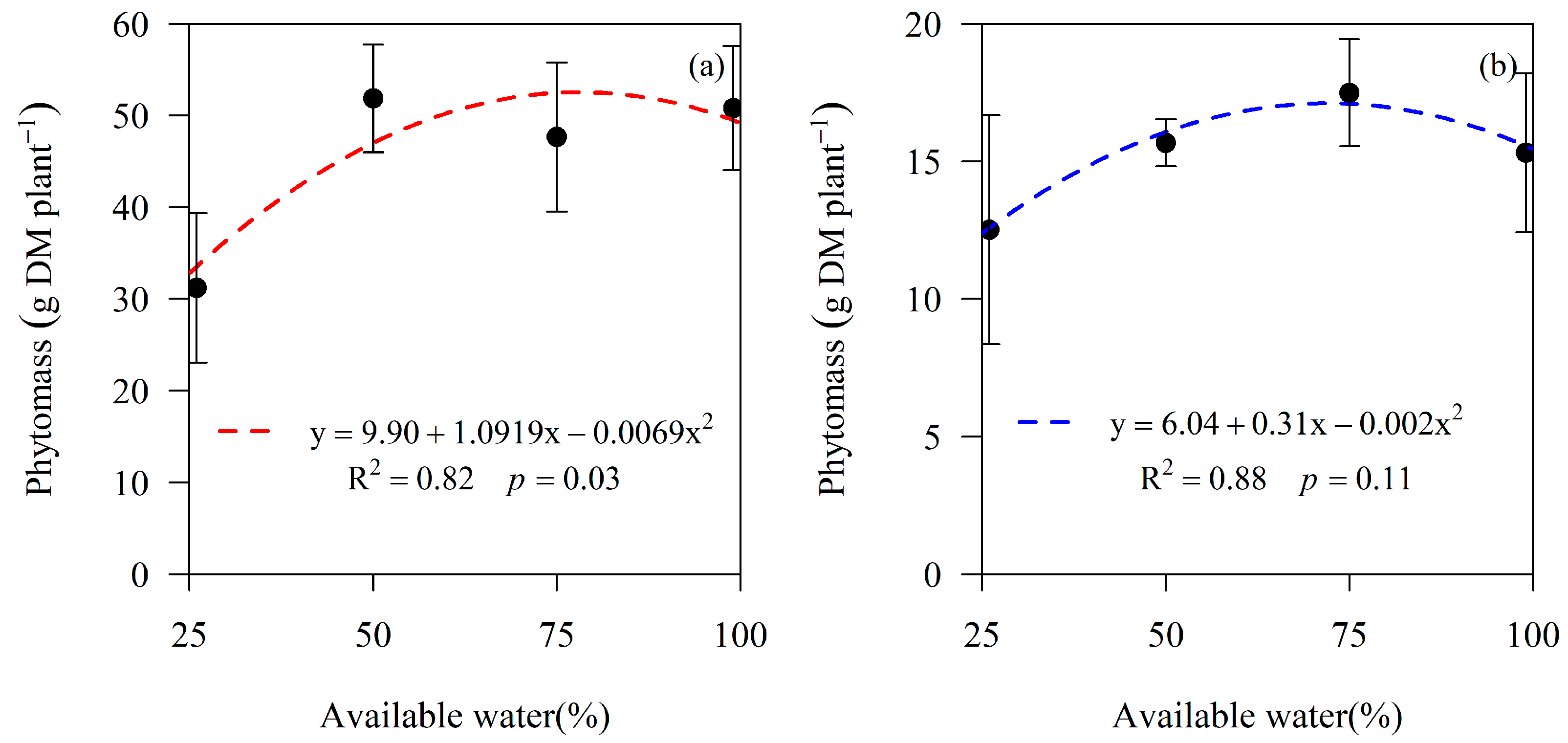
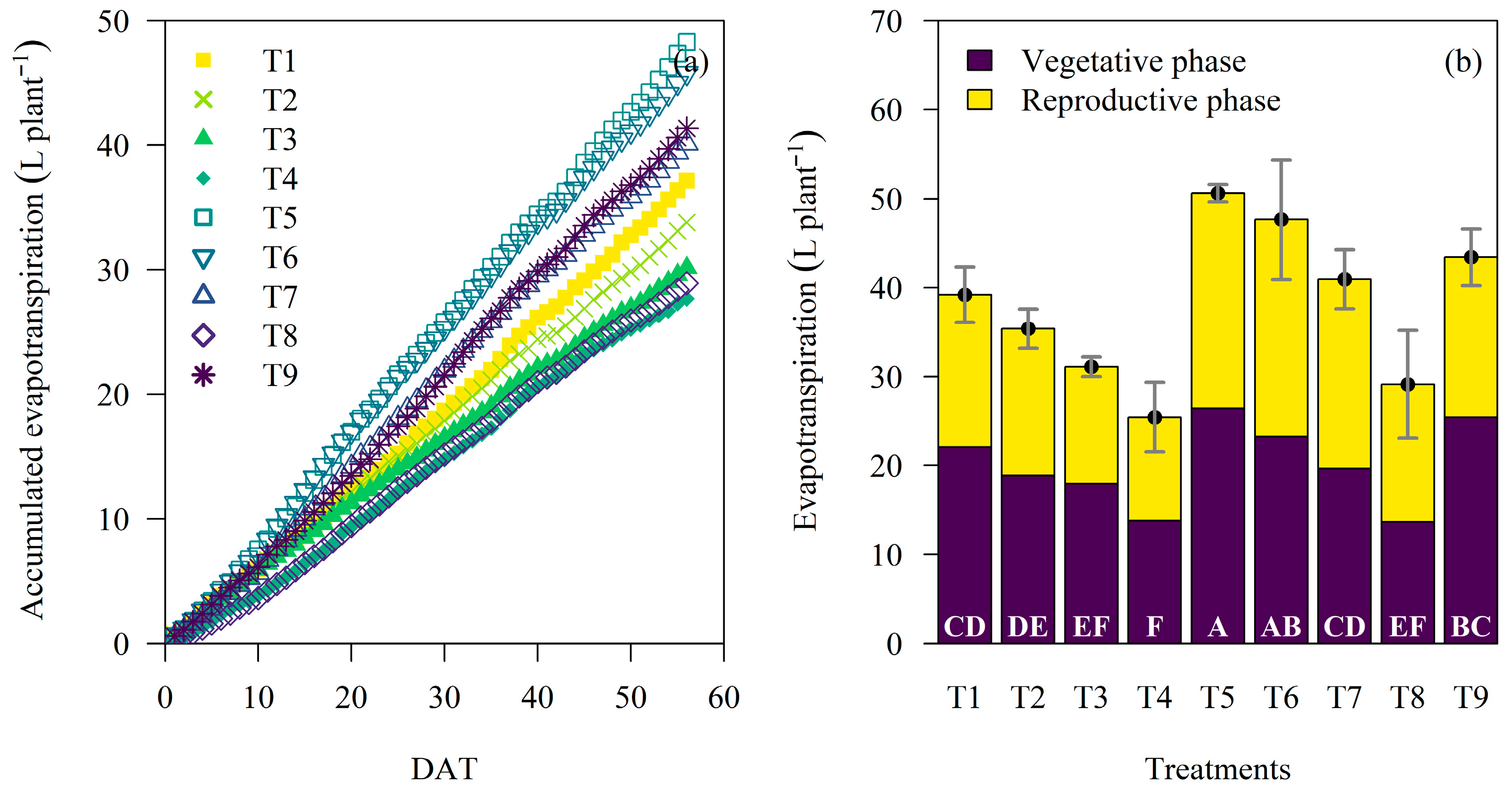
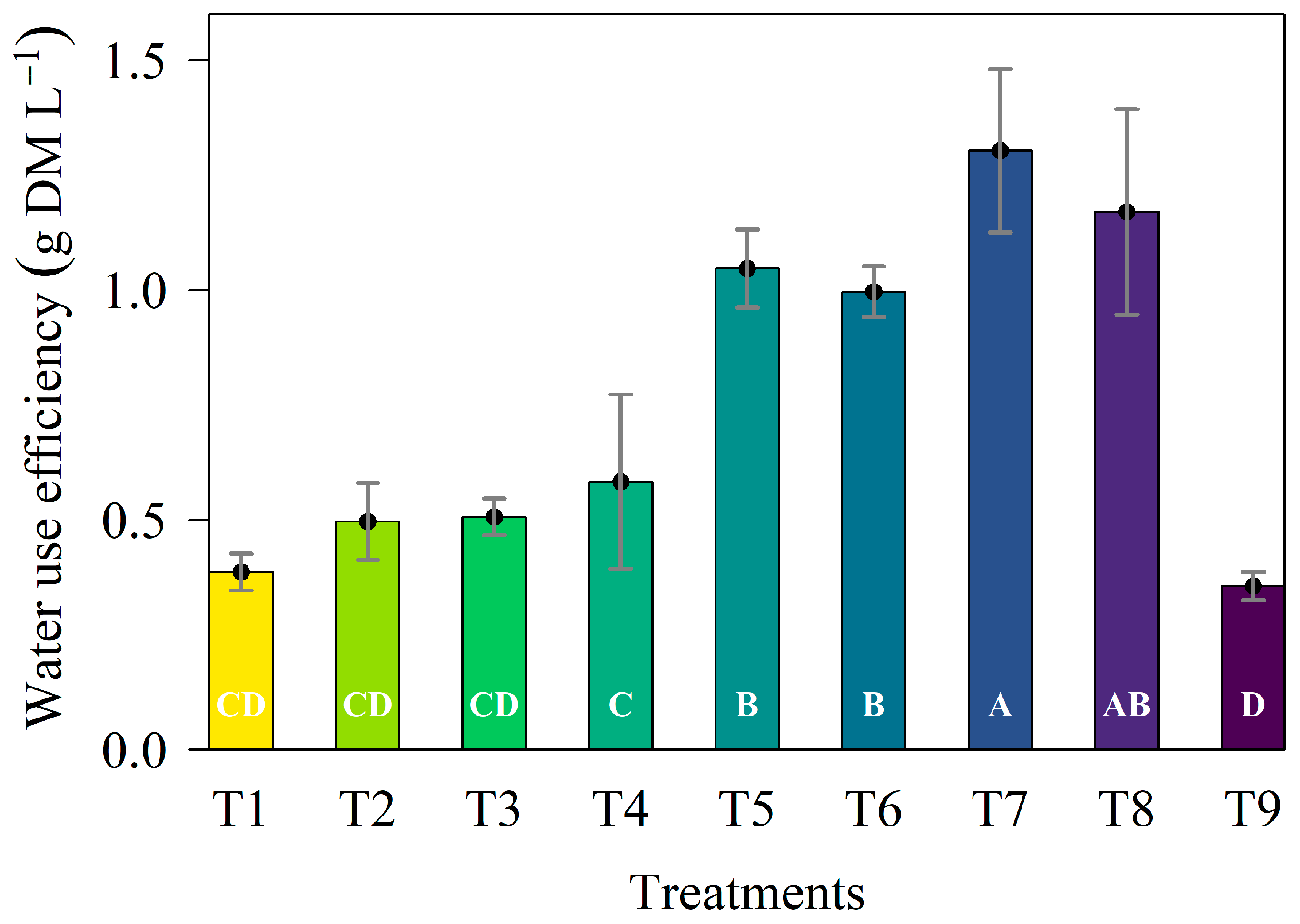

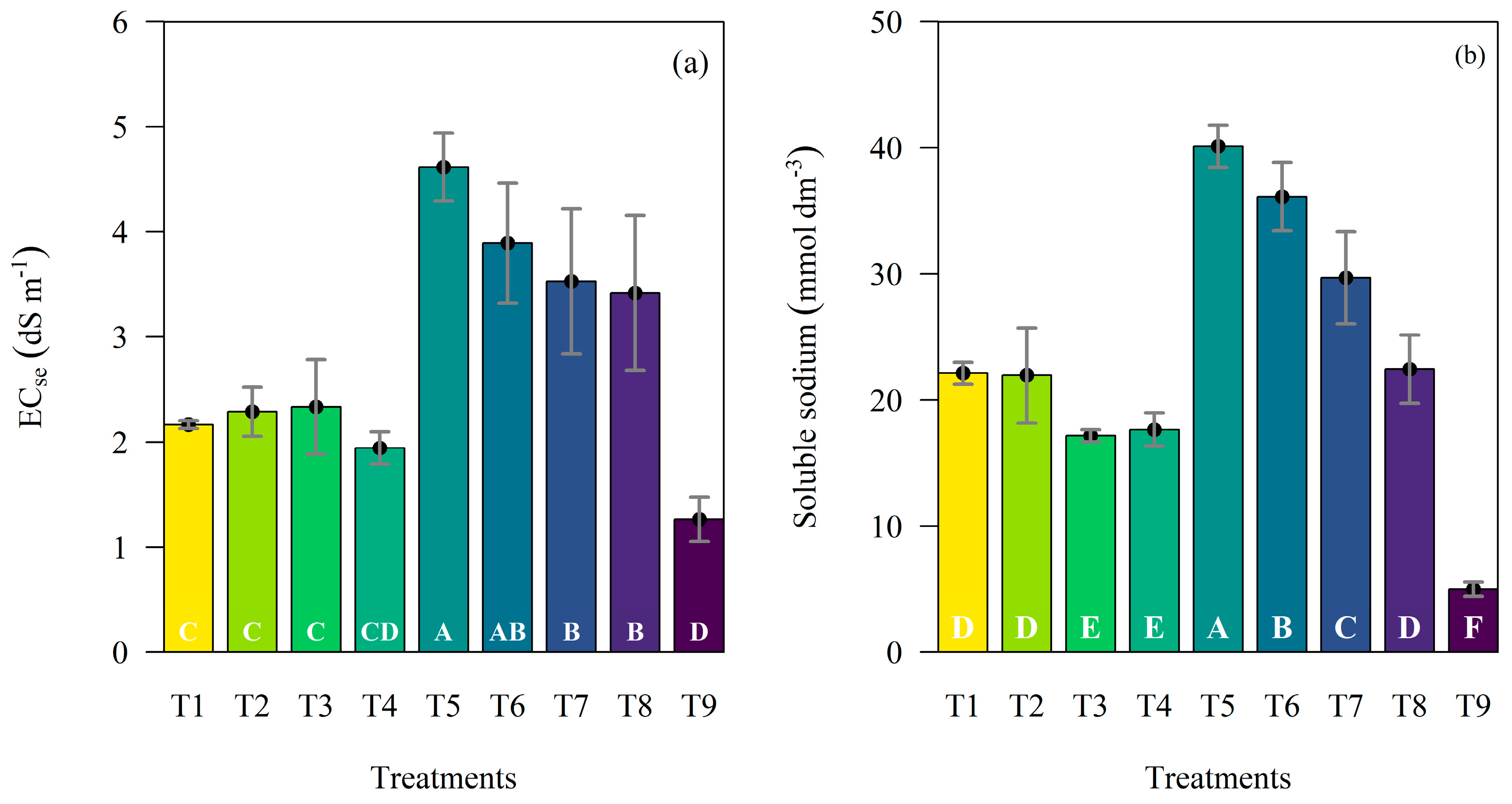

| Element | UW | WW | Element | UW | WW |
|---|---|---|---|---|---|
| Calcium (mmol L−1) | 0.64 | 2.20 | Chlorides (mmol L−1) | 0.60 | 9.60 |
| Magnesium (mmol L−1) | 0.48 | 0.68 | Copper (mg L−1) | 0.04 | 0.06 |
| Sodium (mmol L−1) | 0.32 | 17.04 | Iron (mg L−1) | 0.08 | 0.08 |
| Potassium (mmol L−1) | 0.07 | 0.46 | Manganese (mg L−1) | 0.03 | 0.05 |
| Carbonate (mmol L−1) | 0.00 | 0.24 | Zinc (mg L−1) | 0.05 | 0.05 |
| Bicarbonate (mmol L−1) | 0.40 | 4.00 | Power of hydrogen (pH) | 7.20 | 7.75 |
| Sulfates (mmol L−1) | 0.04 | 0.17 | Electric conductivity (dS m−1) | 0.20 | 0.98 |
| SAR | 0.27 | 8.69 | † Water classification | C1S1 | C3S2 |
Disclaimer/Publisher’s Note: The statements, opinions and data contained in all publications are solely those of the individual author(s) and contributor(s) and not of MDPI and/or the editor(s). MDPI and/or the editor(s) disclaim responsibility for any injury to people or property resulting from any ideas, methods, instructions or products referred to in the content. |
© 2025 by the authors. Licensee MDPI, Basel, Switzerland. This article is an open access article distributed under the terms and conditions of the Creative Commons Attribution (CC BY) license (https://creativecommons.org/licenses/by/4.0/).
Share and Cite
Silva, J.R.I.; Leite, M.L.d.M.V.; Barros Junior, G.; Silva, J.E.d.S.; Silva, E.F.d.; Jardim, A.M.d.R.F.; Barroso Neto, J.; Lima, J.R.d.S.; Antonino, A.C.D.; Souza, E. Evapotranspiration and Inputs of Salts to Soil in Irrigated Millet with Wastewater. Appl. Sci. 2025, 15, 9612. https://doi.org/10.3390/app15179612
Silva JRI, Leite MLdMV, Barros Junior G, Silva JEdS, Silva EFd, Jardim AMdRF, Barroso Neto J, Lima JRdS, Antonino ACD, Souza E. Evapotranspiration and Inputs of Salts to Soil in Irrigated Millet with Wastewater. Applied Sciences. 2025; 15(17):9612. https://doi.org/10.3390/app15179612
Chicago/Turabian StyleSilva, José Raliuson Inácio, Mauricio Luiz de Mello Vieira Leite, Genival Barros Junior, Josefa Edinete de Sousa Silva, Elania Freire da Silva, Alexandre Maniçoba da Rosa Ferraz Jardim, Juracy Barroso Neto, José Romualdo de Sousa Lima, Antônio Celso Dantas Antonino, and Eduardo Souza. 2025. "Evapotranspiration and Inputs of Salts to Soil in Irrigated Millet with Wastewater" Applied Sciences 15, no. 17: 9612. https://doi.org/10.3390/app15179612
APA StyleSilva, J. R. I., Leite, M. L. d. M. V., Barros Junior, G., Silva, J. E. d. S., Silva, E. F. d., Jardim, A. M. d. R. F., Barroso Neto, J., Lima, J. R. d. S., Antonino, A. C. D., & Souza, E. (2025). Evapotranspiration and Inputs of Salts to Soil in Irrigated Millet with Wastewater. Applied Sciences, 15(17), 9612. https://doi.org/10.3390/app15179612








